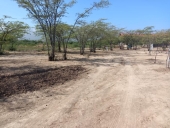posted 12 years ago
Hi all
I have a 4 hectare lake (10 acres). It is a man made lake, about 40 years old. It receives water from the local river, via a trout farm, then, it returns the water back to the same local river via what used to be a small hydroelectric plant.
It is all fallen into disrepair, and needs attention.
The turbine doesn't run, we were told the reason is that some metal grid fell into the pipe that lead the water from the lake to the turbine. The pipe is under water, so we have not seen it - to see it, we would need to lower the level of the lake. This we plant to do one day ...
The lake is very muddy. We don't know the exact nature of the mud. The shallower ends of the lake are overgrown with rushes, sedges, etc, and every year, they make new inroads into the lake - about a meter a year. If nothing is done, then one day there will not be any lake left... As the lake was also receiving the waste from the trout farm in the past, my guess would be that most mud would be of organic nature - in other words, plant and animal matter in different stage of disintegration. I think that the mud is less than a meter deep - mayeb a coupel of feet in some places, and in others less. We were told we would need to dredge the lake, but then, I read somewhere that it may be possible to deal with it differently: treating it with enzymes and lime and other things, which should "eat" the mud, and return it into a form usable by plants and other living organisms.
In the past also, we were told, there was fishing on the lake. It does seem to be an obvious source of potential income, but, we fear we would lose the lake to the fishermen that way. We fear that our lake would end up full of old hooks, and nylon, and whatnot, and it would not be safe for swimming any more. And to swim in it in the summer, with nobody around, just us, is simply magic.
My preference, my dream, is this:
Clear the lake off mud, and create what in effect would be a huge natural swimming pond. Plant it up with pants for filtering purposes, as well as for beauty. One or two little jetties, some nice accessible corners to get in and out, et voila! Plant the surrounding areas with trees and bushes that mirror in the water. I would like to open it to limited numbers of visitors who would appreciate swimming in nice surroundings, or simply watching it and relaxing next to the water. At some point during this work also repair the turbine, so we can have some free electricity as well.
Now, my questions...
1. how to determine the nature of the mud (organic? inorganic?)
2. what is the simplest and the most economical way of clearing the mud off the bottom of a lake - about half of which is shallow (less than 3 feet deep)
3. what is the best way to plant it up with filtrating and other plants - considering its size. In the swimming pond the plants would be planted in the gravel - but, the cost of getting so much gravel as to cover 2 hectares of lake is prohibitive. How to go about it instead? Plants in pots of gravel? Any other ideas? Does the swimming area need to be separated from regeneration area by walls? What would happen if they were not separated? (I see no particular problems there, but wonder if other people may see some other angles?)
4. what are the best plants to plant it up with so that the maintenance is minimal, but oxygenation, filtration and beauty are at their best?
5. how to prevent spreading of sedges and rushes another meter into the lake every year? Would digging of a ditch to make water too deep for them work? If not, why not? How to keep that ditch from filling up with mud in the future? What else may work instead?
I would appreciate your thoughts and ideas. Many thanks.
Happy work!
Warm regards,
Yves







